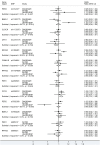Circadian gene variants and susceptibility to type 2 diabetes: a pilot study
- PMID: 22485135
- PMCID: PMC3317653
- DOI: 10.1371/journal.pone.0032670
Circadian gene variants and susceptibility to type 2 diabetes: a pilot study
Abstract
Background: Disruption of endogenous circadian rhythms has been shown to increase the risk of developing type 2 diabetes, suggesting that circadian genes might play a role in determining disease susceptibility. We present the results of a pilot study investigating the association between type 2 diabetes and selected single nucleotide polymorphisms (SNPs) in/near nine circadian genes. The variants were chosen based on their previously reported association with prostate cancer, a disease that has been suggested to have a genetic link with type 2 diabetes through a number of shared inherited risk determinants.
Methodology/principal findings: The pilot study was performed using two genetically homogeneous Punjabi cohorts, one resident in the United Kingdom and one indigenous to Pakistan. Subjects with (N = 1732) and without (N = 1780) type 2 diabetes were genotyped for thirteen circadian variants using a competitive allele-specific polymerase chain reaction method. Associations between the SNPs and type 2 diabetes were investigated using logistic regression. The results were also combined with in silico data from other South Asian datasets (SAT2D consortium) and white European cohorts (DIAGRAM+) using meta-analysis. The rs7602358G allele near PER2 was negatively associated with type 2 diabetes in our Punjabi cohorts (combined odds ratio [OR] = 0.75 [0.66-0.86], p = 3.18 × 10(-5)), while the BMAL1 rs11022775T allele was associated with an increased risk of the disease (combined OR = 1.22 [1.07-1.39], p = 0.003). Neither of these associations was replicated in the SAT2D or DIAGRAM+ datasets, however. Meta-analysis of all the cohorts identified disease associations with two variants, rs2292912 in CRY2 and rs12315175 near CRY1, although statistical significance was nominal (combined OR = 1.05 [1.01-1.08], p = 0.008 and OR = 0.95 [0.91-0.99], p = 0.015 respectively).
Conclusions/significance: None of the selected circadian gene variants was associated with type 2 diabetes with study-wide significance after meta-analysis. The nominal association observed with the CRY2 SNP, however, complements previous findings and confirms a role for this locus in disease susceptibility.
Conflict of interest statement
Figures
References
-
- Chaput JP, Despres JP, Bouchard C, Tremblay A. Association of sleep duration with type 2 diabetes and impaired glucose tolerance. Diabetologia. 2007;50:2298–2304. - PubMed
-
- Karlsson B, Alfredsson L, Knutsson A, Andersson E, Toren K. Total mortality and cause-specific mortality of Swedish shift- and dayworkers in the pulp and paper industry in 1952–2001. Scand J Work Environ Health. 2005;31:30–35. - PubMed
Publication types
MeSH terms
Substances
Grants and funding
LinkOut - more resources
Full Text Sources
Other Literature Sources
Molecular Biology Databases


